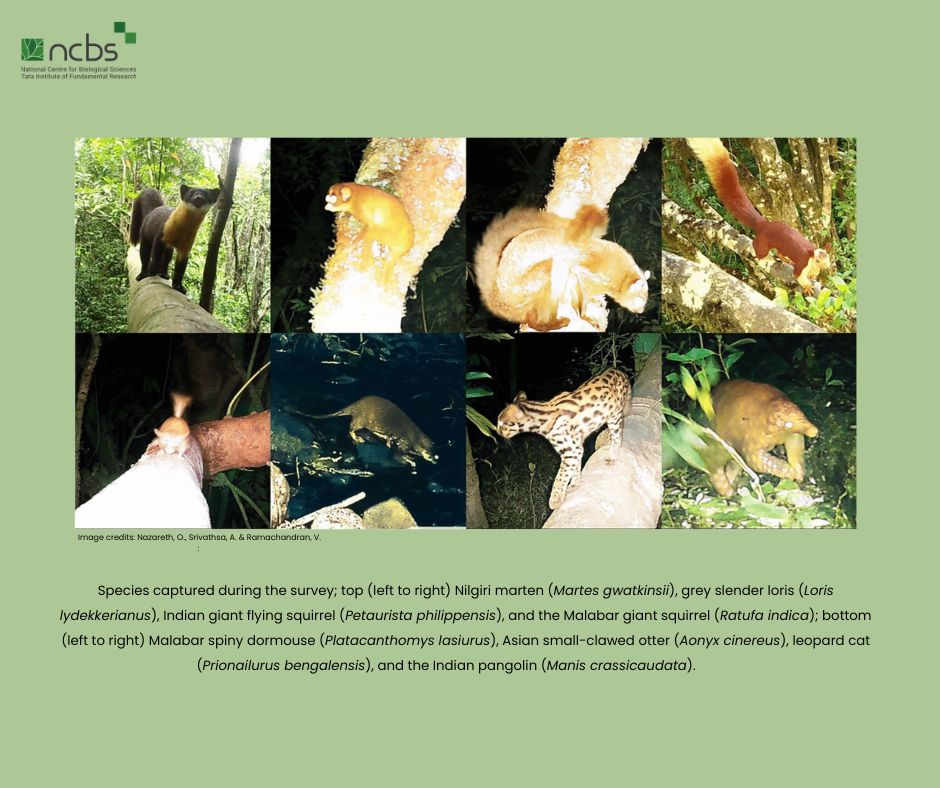The Western Ghats rainforests harbor many elusive and rarely spotted species such as the Nilgiri Marten and the Malabar Spiny Dormouse among many others. However, information on such elusive or rare species are limited, making it difficult for scientists and researchers to study and conserve them. In a recently published paper titled “Trunks and Treetops: Integrating Terrestrial and Arboreal Camera-trap Surveys to Document Elusive Mammal Communities in India” and published in the journal Mammal Research, researchers from NCBS introduce an innovative approach where camera traps were set-up in the canopy to document arboreal mammal species.
Camera traps have been a game-changer in studying wildlife. But, their application to study arboreal mammals has been very limited. This study bridges that gap by comparing the effectiveness of camera traps in documenting both terrestrial and arboreal mammals, in rainforests of the Western Ghats.
In the pre-monsoon months of 2022, the research team, deployed 29 camera traps across a 70-hectare area in Western Ghats of Karnataka. Thirteen traps were strategically placed on ground, covering sites along roads, dry river beds, foot trails, and near fallen logs. Simultaneously, 16 sites had camera traps set up in the canopy between 4-15 meters off the ground. The team also experimented with different baits, using mashed and fermented fruit, honey-drizzled fermented fruit, dry fish, and a combination of dry fish and shrimp paste to attract mammals.
Of the 36 mammal species documented in the area, 28 were captured on cameras within 50 days. 14 of these were arboreal species. While this timeframe may not have been adequate in capturing all terrestrial mammals, it proved sufficient in documenting all arboreal species found in the region. The baits used also proved to be useful in attracting species to the camera traps. While rodents showed no clear preference for bait, carnivore species exhibited a strong preference for shrimp paste and dried fish. The study also recorded an impressive 15 independent captures of Nilgiri Marten in less than 50 days.
To quantify the degree of arboreality of a species, the researchers introduced an arboreality index (AI) ranging from 0 (terrestrial) to 1 (arboreal). Calculated for every species captured in the camera traps, it served as a valuable metric, providing insights into the habitat preferences of different mammal species. The Nilgiri Marten scored a high 0.7 on this index, indicating a strong association with arboreal habitats and so did the Nilgiri Long-Tailed Tree Mouse, another elusive and rare species with an AI score of 0.6. Furthermore, the researchers have also shared insights into the climbing techniques and equipment used during the study, providing guidelines for future arboreal research endeavours.
This study underscores the effectiveness and utility of camera traps in documenting rare and elusive arboreal species. The authors hope that these findings will encourage more researchers to adopt camera trap methodology for a broader and more comprehensive understanding of arboreal species.
The paper can be accessed at shared link; Nazareth, O., Srivathsa, A. & Ramachandran, V. Trunks and treetops: integrating terrestrial and arboreal camera-trap surveys to document elusive mammal communities in India. Mamm Res (2023), https://doi.org/10.1007/s13364-023-00714-1.










0 Comments